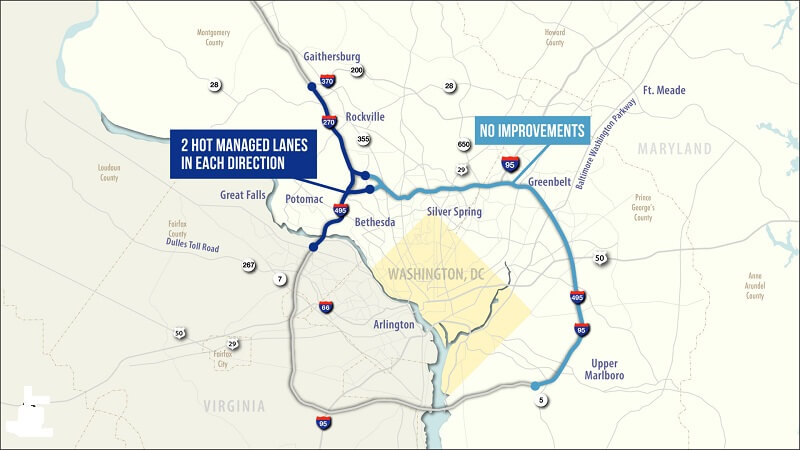Opinion: Lessons learned from Boston could shape a more collaborative process on I-495 toll lanes project

By Arthur Katz
The writer is a resident of Rockville and critic of former Gov. Larry Hogan’s proposed toll lane project along the D.C. Beltway.
There has been a long running controversy about the value of adding toll lanes to portions of I-270 and I-495. Many options and alternatives have been proposed in place of present plans, but the approach driven by controversy has been unsystematic – lacking a serious dialogue.
In contrast, I was recently on a Zoom call that celebrated the 50th anniversary of the November 30, 1972, decision by the Republican Governor of Massachusetts Frank Sargent to eliminate all the proposed urban highways in the Boston region except for one in construction and substitute mass transit. In addition, associated with that decision was a successful bipartisan campaign to open the federal Highway Trust Fund to permit mass transit funding.
Among those on the call were two former secretaries of Transportation for the state of Massachusetts: Alan Altschuler, a noted political science who was recognized for studies of urban freeway controversies, and Frederick Salvucci, who subsequently spearheaded successful actions to replace a massive, elevated steel section of highway in the heart of Boston with an underground alternative that changed the face of downtown. Also participating were John Wofford, the Boston Transportation Planning Review (BTPR) director who subsequently became the deputy general counsel of the U.S. Department of Transportation, as well as the former Congressman Barney Frank, and several participants who would become important planners, politicians, and community leaders.
Most relevant to the present situation is the meaningful influence of the unique Boston Transportation Planning Review planning process on the final decisions and actions. The BTPR was funded as the prototype for U.S. Department of Transportation regulations for the Environmental Impact Statement process — it was 1970 and the National Environmental Policy Act had just become law. The BTPR was, in the opinion of many, one of the best, if not the best, participatory transportation planning processes over the last 50 years. At least two books have been written about it.
I had the opportunity to be the chief negotiator in this process for the largest coalition of community and private interest groups, including environmental groups in the Boston region called the Greater Boston Committee on the Transportation Crisis. What made the BTPR process distinctive and important was that public and interest groups (from construction unions to local communities) as well as was public officials were present at the table and represented from the earliest moments in the discussions of the detailed design of the study, the selection of contractors and the monitoring of the products of the study as they were produced.
Further, the BTPR incorporated specific staff to act as an ongoing liaison between the technical staff and various community officials and the public in different physical sectors of the Boston region — to assure a communication flow in in both directions
In contrast, the current process for the I-495/ 270 Study was poorly conceived — resembling the pre-ordained 1960s view of highway construction. The current process used public input more as a PR mechanism that adjusted concerns and problems at the margins of the design just enough, but never created the transportation planning process that seriously looked at the options.
The current process is a failure of politics and imagination. It was based on the political mantra “we will build it and you will not have to pay for it.” Once that idea was embedded in the process, only toll road projects made sense. Moreover, in the desperate search for the politically acceptable, the Maryland Department of Transportation delayed the most politically sensitive eastern Beltway portion of the toll road, ending it between the I- 270 spurs — and in the process created a massive congestion chokepoint when the toll lanes end, undermining the overall viability of the project.
The Maryland Department of Transportation and the state’s governor, comptroller and treasurer, who sit on the Board of Public Works that control the approval of public-private projects, should revisit the whole process that underpinned the decisions. The BTPR model is worth looking at not because it exactly matches the current study needs, but because it navigated the highly charged political process in Boston to produce a workable result.




 Creative Commons Attribution
Creative Commons Attribution